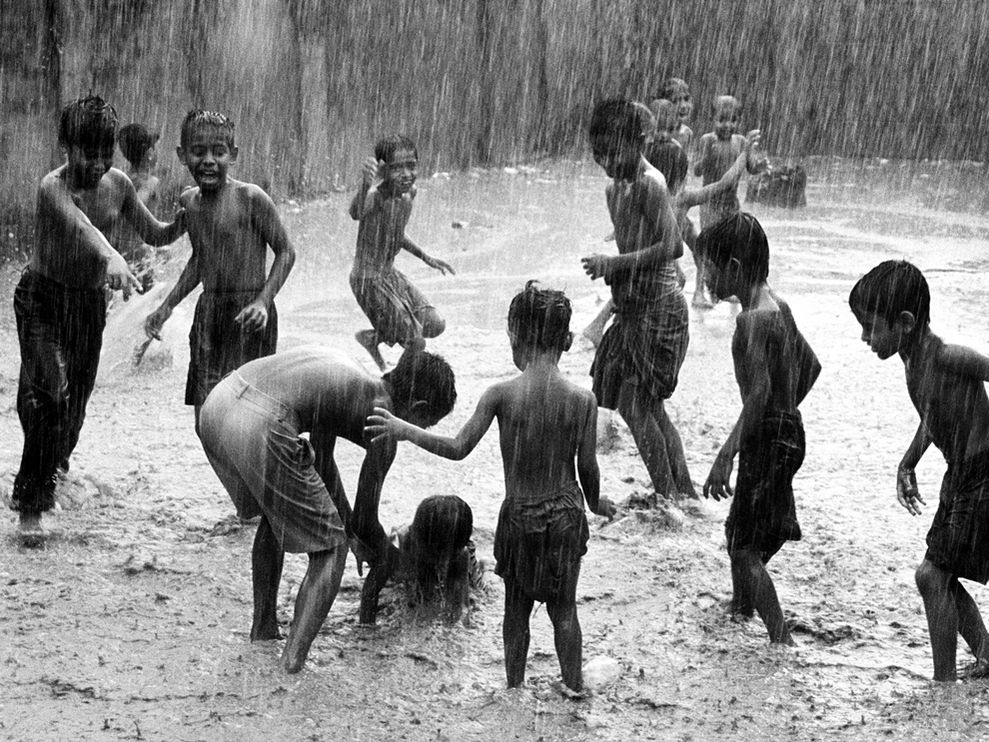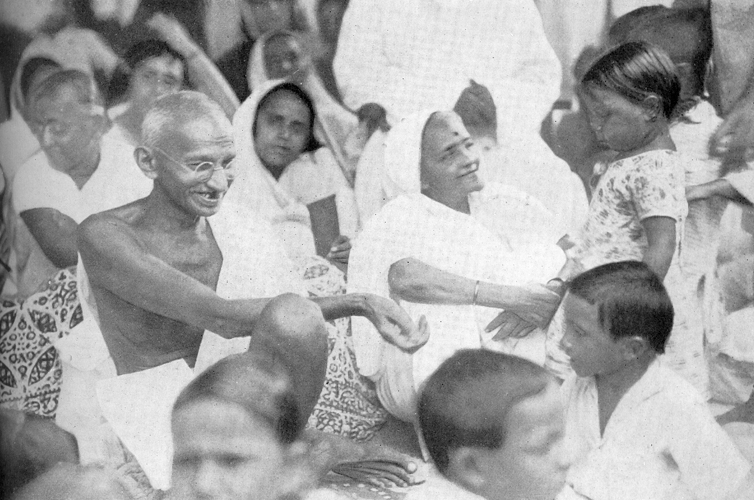The union between the physical and the mental seems to be our only hope for redemption for a world free from fear. How can we think of a model that focuses upon the holistic development of the child and not her fragmented parts? Here a researcher explores the relevance of the Gandhian philosophy of education in order to cope these puzzling issues.
By Nidhi Gaur is a doctoral student in C.I.E, University of Delhi.
News about road rage incidents, violence against women, kidnapping and assault of young children are not standalone unfortunate incidents anymore. In evenings, when I used to cycle around with friends, my mother’s worst worry was that I might get accidently hit. The world was not free from violence then but the fear was not as heightened as it is now. Today, I see parents mostly mothers tagging along their children and instructing them not to cycle too fast that she loses sight of them. Children are playing in a park inside a middle class colony with gates manned by security guards and properly functioning CCTV cameras. In a park inside residential colony like this, children were playing and their mothers were surrounding the play area keeping a watchful eye on them.
It was pleasant winter evening, not too breezy and grandparents were sitting in their balconies of three storied buildings surrounding this small park, occasionally greeting each other from far by waving and smiling. But mostly they were happy to see toddlers and young children playing in the park. Then suddenly a young mother notices her five-year-old son is not in sight anymore. She jumps and starts running around looking for him teary eyed. I happened to pass by her and looking at her agitated state, I tried comforting her while also helping her to look for her son. It is a safe place, he must have just wandered off, I tell her but to no avail. We found her son happily playing in soil in one building compound just a few moments later. She ran and first hugged him and then slapped him for running away like that. The bewildered child starts crying and the mother drags him to their house, which is in the next compound. Her sense of relief made me wonder about this fear we are living with. We have altered our everyday because of this fear.
It is the same place I used to play twenty years ago and my mother could not have watched me as she would be in our house. We jumped boundary walls of the roofs of one house to another to reach the farthest end without climbing stairs.
We burnt paper and plastic to smell and observe how they burnt. We broke bricks with bigger bricks or stones to see how its powder looks, smells like or tastes like. We played with sand and clay and soil and we filled them all in our fists and tried to hold them for as long as possible. We didn’t want our parents to know or they may not have allowed us.
I felt sorry for this five-year-old who cannot even explore this otherwise safe residential area because his parents are afraid he might get abducted. Reading these kinds of reports in the newspaper every day, I cannot completely blame the mother. But isn’t this fear taking his childhood away and restricting him to stay indoors in the watchful eyes of his mother or father or grandparents? Secondly, how will this child make sense of this unexpected hug and slap? Will it make him more cautious and distrustful and fearful? If it does, then is it healthy?
Fear is intimately connected to violence. There is one obvious connection of violence leading to fear. But it is fear that breeds violence. Fear of losing something tangible or intangible would lead to violence. So, there is a probability that instilling fear in a child with the best intentions to keep him safe will result in some kind of violence. Because it will develop an urge to protect him and in many cases it takes the turn of the offensive rather than defensive. I will attack you before you could have a chance. So this fear is not an answer to the violence we have to deal with.
True swaraj is to be able to live without fear, Mahatma Gandhi explained in Hind Swaraj. He said that fear resides inside us and not outside. No amount of external security can make us feel secure. Security and courage have to come from within. To strengthen ourselves from within we need to develop control over our body, mind and spirit. He explained that our strength lies in self-reliance, self-awareness and self-discipline. Practicing these three principles in our everyday life would give us the courage to be truthful and non-violent, that is, to live without fear.
These three principles became the foundation of Nai Talim or craft centered education. He believed that the practice of crafts will help children in developing control over their body and mind. It will direct them to a path of self-exploration leading to self-awareness. Control over their body and mind will help them follow their own truth with conviction. Through an illustration an attempt is made to explain how these three principles unfold in craft centered education.
Bell rang and teacher left the classroom. Students quickly packed their bags and put them in a corner of the room. Together they stacked their low floor benches at the back of their room. Then they picked up their mats and went out. Three boys were running a bit late, so they were the last ones to leave. But before leaving, they looked around the classroom and then one of them quickly ran to put chalks and duster at the right place while other two put their shoes on and left with mats in their hands. The last boy bolted the classroom door and followed them. They walked through the sand floor leaving cottages behind towards the end of the large ground towards an elongated cottage like structure with mud tiled roof. They took off their shoes outside the door. This was their spinning cottage. They placed their mats on the floor and went to pick up book charkhas and spinning box stacked neatly on the table near the entrance of the rom. There was noise of students settling in, keeping their small tin boxes and book charkhas on the floor. A girl was now comfortably seated next to her friends. She opened her charkha and attached thread to the wheel and the spindle, which she placed on the wooden holder. She kept the charkha parallel to her right leg and placed her thigh on the wooden border of charkha to prevent it from shifting while spinning. Once comfortable, she opened her spindle box and took out a cotton pencil. She closed the box and put it aside. Then she rolled out some already spun thread by rotating the wheel of the charkha anti-clockwise. She picked up the thread and observed it carefully. She took the cotton pencil in her left hand and held the loose fibres at the end of the thread on top of the cotton pencil by placing it under her left thumb. She then began rotating the wheel clockwise and then she pulled her left hand away and thread began to come out from a cotton pencil. She rolled this newly cotton thread on the spindle simultaneously spinning more new thread. After a few minutes of working spinning silently, she started humming. For the first few minutes there was complete silence in the spinning room with the only noise coming out of the rotating wheel. But once settled, students started talking and spinning. But none of them left their eyes wander and their body shift even for a moment.
This illustration began with the ringing of the bell prompting students to clear their class before leaving. The last boy made it a point to check the entire room and see if anything was left out of its place and he kept chalk and duster at its designated place. He remembered to bolt the door before leaving. The students were clearing their classroom for shramdan, which was their next activity after spinning. In this activity, the entire student and teacher community is divided into pairs and they all have designated tasks to do. Some sweep classrooms, others dust furniture, rest collect garbage etc. But all of them understand that it would be easy to clean the room if it is already cleared, so they make it a point to do it before going to their next class. This is a cooperative activity and it brings them all together. This is also the last activity of the day.
These students were going for spinning classes. Every student followed the same routine of placing their mats on the preferred spot on the floor and then they look for their box and charkha come back to their seat and start working. There is no fixed seating arrangement. They open their boxes only when they are comfortably seated. Comfortable seating posture is important to concentrate on spinning because discomfort will distract them and make them shift their body, which will either break the thread or compel them to change their position. So, students do not hurry to start spinning. They spent required amount of time at every step of the process. Once seated they open book charkha and assemble it. Each step is important thus needs to be executed carefully, it includes right placement of the book charkha and also holding it under your thigh so that it does not move while spinning. Then holding the loose end of the thread on top of the cotton pencil with a thumb is a critical step too. Thumb should not tight grip the thread as the loose ends may not be able to reconnect. It needs to just hold it to enable this delicate reconnection through the rotating of the wheel, which twists these fibres on the cotton pencil and tightens its grip. Then the act of stretching the cotton pencil makes the thread, which is immediately rolled on the spindle through rotating the wheel.
Towards Integral Learning
Executing all these steps requires concentration; therefore, there was complete silence in the room when students were beginning this process. But once they reach that peaceful and unwavering state of mind, they could talk without taking their eyes off or moving their body a bit. When the thumb lightly holds thread with cotton pencil, the stretching does not begin immediately by the child. She waits for a signal from the sensitive thumb to begin this stretching. The signal is the feeling of the tightening of the grip of the loose ends of thread with cotton. If the grip becomes too tight then it will be difficult or even nearly impossible to pull without breaking. And if it’s too light then it will break on pulling. So, the act of pulling has to be at the right moment. The child learns to feel and identify this right moment. One the thread starts spinning then right amount of pressure needs to be applied in pulling too much or too little will break the thread.
In other words, body and mind needs to be in sync with the rotating wheel and also aware of the delicate nature of the thread. This awareness and sensitivity is developed over a period of time. In other words, practice of spinning facilitates in the development of control over body and mind. It strengthens our sensory organs, thus improving our perception of reality. This control over our mind and body is developed in the light of its immense potential. This awareness of potential gives us security and fearlessness. It makes us rely on ourselves, on our mind and body in difficult situations. It strengthens our inner self.
The above illustration is just a peak into the practice of crafts. The objective was to present the potential of craft centered education in the holistic development of the child. Craft centered education is a thoughtfully created plan of experiences arranged in a sequential manner to facilitate in intellectually engaging the inquisitive child along with her childhood impulses.
I began this article by discussing fear and how fear is altering our everyday life experience. It is also shaping the childhood experiences of our children, whose physical development is affected because of the fear that resides inside us. Mahatma Gandhi presented the solution of strengthening the inner domain to deal with adverse situations. This kind of education was his solution to strengthen our inner self. But the question is, borrowing Ursula Franklin’s phrase, in this ‘real world of technology’, where we depend on CCTV cameras and other mechanical objects, can we still find spinning relevant? We are ready to spend millions to develop technology; do we have enough time and money to strengthen our inner self and our children?
This article is published in The New Leam, March Issue( Vol.2 No.10) and available in print version.
To buy contact us or write at thenewleam@gmail.com Or Visit Flipkart.com












